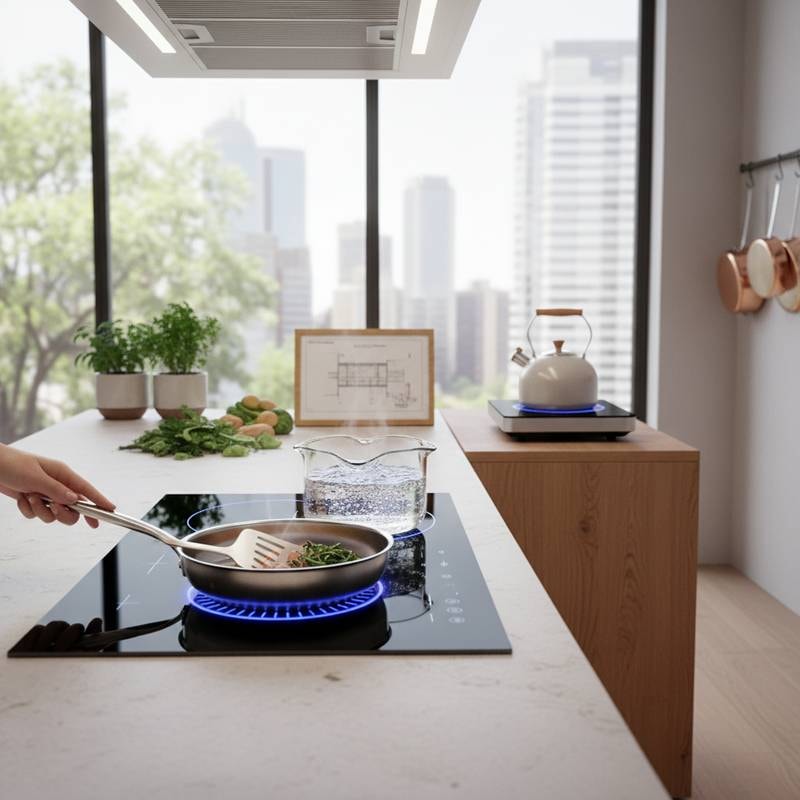Induction Zones: The Smart Switch from Gas Cooking
Induction zones represent a modern advancement in kitchen technology, offering faster, cleaner, and more precise cooking experiences. Homeowners designing new spaces, updating rentals, or renovating affordably benefit from the control and safety these systems provide. The transition from gas cooking suits any budget, delivering results that enhance daily meal preparation.
Why Many Cooks Choose to Abandon Gas
Gas stoves dominated kitchens for years due to their immediate flames, visible heat adjustment, and professional appeal. However, advancements in technology have shifted preferences toward induction. This method employs magnetic energy to heat cookware directly, bypassing the surrounding air and surface, which results in quicker heating, responsive adjustments, and a cooler kitchen environment.
Homeowners often express enthusiasm upon discovering induction's efficiency and responsiveness. Consider boiling water in half the usual time or maintaining a delicate sauce at an ideal simmer with minimal intervention. Such precision appeals to professional chefs and home cooks alike. For those concerned with gas odors or the hazards of open flames around children, pets, or fabrics, induction offers significant reassurance.
How Induction Zones Function
An induction zone features electromagnetic coils under a glass surface that generate a magnetic field. This field activates the molecules in compatible cookware, making the pot or pan the direct heat source. Consequently, energy use becomes more efficient, cooking times shorten, and cleanup simplifies since spills do not bake onto the relatively cool glass.
To determine if existing cookware suits induction, test with a magnet against the pan's base. A strong attachment indicates compatibility. Materials such as cast iron, enameled steel, and most stainless steel perform well. Non-magnetic options like aluminum, copper, or glass require a magnetic base but induction-compatible sets start at approximately $60 and yield excellent results.
Budget-Friendly Options for Every Kitchen
Accessing induction technology requires no extensive overhaul. Consider these three approaches to integrate it effectively:
-
Portable Induction Burners: Available for less than $100, single or double burners connect to standard outlets and deliver immediate advantages. They suit apartments, dormitories, or compact spaces. Professionals often select them for their portability and quick response during on-location tasks.
-
Built-In Induction Cooktops: Compact models begin at around $500 and install into existing countertop openings. Select configurations with two, four, or five zones based on available space and cooking needs.
-
Complete Range Upgrades: Induction ranges merge a smooth cooktop with an electric or convection oven, starting near $1,000. Align purchases with manufacturer rebates or energy incentives to reduce costs substantially.
These choices align with diverse financial plans. Families have transitioned for costs lower than a gas line repair, reporting lasting satisfaction.
Design and Performance Advantages in Practice
Induction zones contribute a minimalist aesthetic to kitchen designs through their smooth glass surfaces, which clean easily and complement various styles. Pair black glass units with white marble, concrete, or butcher block for a contemporary yet inviting appearance. The seamless layout fosters a spacious feel, ideal for photography in media or property listings.
Performance-wise, induction matches gas's instant response while providing greater accuracy. Melt chocolate in a pot without a double boiler or sear proteins perfectly without flare risks. Advanced models include bridging zones that merge burners for larger cookware or griddles, emphasizing functional innovation and user convenience.
Installation and Conversion Guidance
Converting from gas to induction proves simpler than anticipated in many cases. A dedicated 240-volt circuit may be necessary, which a qualified electrician can install efficiently. Kitchens wired for electric ranges facilitate an even smoother process. Verify electrical panel capacity prior to selection and ensure adequate clearance and ventilation in the layout.
Renters or those hesitant about permanent changes can begin with portable burners, which operate via standard outlets. These units also enable safe outdoor cooking, resistant to wind during events.
Environmental and Health Benefits
Induction cooking minimizes indoor pollutants by avoiding combustion byproducts like carbon monoxide. This promotes healthier air for households and reduces overall environmental impact. The cooler operation decreases reliance on air conditioning in warmer regions. Municipalities and builders increasingly promote induction within electrification efforts, appreciating its adaptability in contemporary designs.
Enhancing Daily Kitchen Use
After adoption, induction becomes indispensable for its convenience, safety, and elegant form. Maintain the cooktop with soft cloths and mild cleaners to preserve its condition.
For layout experimentation, position induction zones on a central island to encourage social interaction during preparation. Surroundings remain safe from flames or excess heat. Incorporate a pop-up vent or overhead hood for a refined, professional touch.
Transition to induction for a kitchen that prioritizes intelligence, safety, and style. Experience the precision, efficiency, and satisfaction of cooking powered by magnetic technology.










